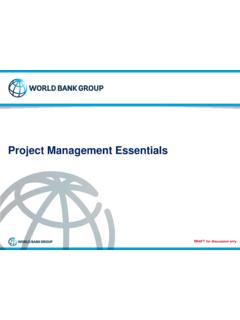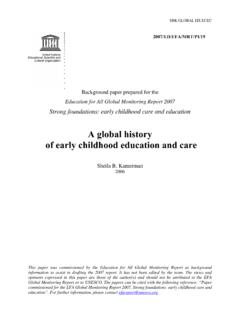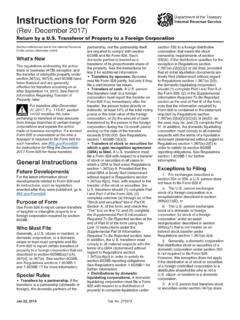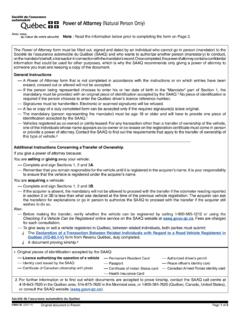Transcription of CASH TRANSFERS: INTRODUCTION & OVERVIEW - World Bank
1 Kat hy L i n d e r t , Wo rl d B an k S o c i al S afet y N et s Co re Co ur s e De c e m b e r 2 014 CASH TRANSFERS: INTRODUCTION & OVERVIEW 1 We have poverty-targeted cash transfer programs in my home country. Your Answers: A. I agree B. I disagree C. I don t know 2 CLICKER QUESTION My job involves working with cash transfer a program (in any country). Your Answers: A. Yes and the program is already operating B. Yes but the program hasn t started yet C. No but we are considering it D. No 3 CLICKER QUESTION OUTLINE What, Why, and When? Basic Design Choices for Cash Transfers Cash Plus: Enhanced Design Options Implementation Matters! 4 5 WHAT ARE CASH TRANSFERS? Cash transfer programs provide (predictable and regular) income support to the poor and certain vulnerable groups 6 COMMON OBJECTIVES OF CASH TRANSFERS Increase the incomes of the poor: Ideally in a predictable manner To help alleviate poverty Also used for redistribution objectives, to compensate for inequality in labor markets Smooth consumption: Help people cope with the consequences of shocks Facilitate other government reforms, , Consolidate other social programs Compensatory measures for other reforms (such as energy subsidies) WHY GIVE CASH?
2 Effective (supply-side factors). Can be cheaper vehicle to deliver benefits than in-kind benefits ( , food) choice (demand-side factors). Because cash doesn t distort consumer preferences or presume to know what the individual families need. 7 If we give poor people cash, they will just spend it on stuf f like alcohol, tobacco, or luxury items. Your Answers: A. I agree B. I disagree C. I sort of And I sort of disagree 8 CLICKER QUESTION HOW DO BENEFICIARIES SPEND THEIR CASH? M o s t o f Pa nt awid c a s h g rant s fi nanc e b as i c ne e d s : Fo o d ( a l m o st h a l f o f g ra nt s ) Sp e nd ing i n H u man C a p i tal ( 2 5 % e d u c at io n, 7 % h e a lt h) V i r t ua lly n o ne o f t h e m f i na nc es r e c rea t io n o r a l c o ho l. Data source: FIES 2012 9 Example from Philippines CCT When is Cash Appropriate? Situations of Chronic Pover ty Situations of Shocks Emergencies with adequate food supply Transitory shocks When deliver y of benefits feasible: Access to financial facilities (permanent or mobile) Food and other necessities are available When is Cash Inappropriate?
3 W h en s u p p ly o f e s s e nt ial g o o d s d i s rupted ( wa r s , na t u ra l d i s a ster s ) S h a l low fi na nc i al m a rket s ( h ard to move c as h ) W h en s a fety net i s f u nd e d wi t h i n-k i nd c o nt ri b u tio ns ( fo o d a i d ) 10 WHEN & WHEN NOT TO USE CASH AS PART OF THE SAFET Y NET Plus Political Economy Considerations Philippines Typhoon Yolanda 2013 7 million people af fected, 4 million people displaced Pantawid CCT transfer s were distributed as par t of a broader response (also food, shelter, reconstruction, etc.) Conditionalities for education & health waived during disaster (as a matter of policy) Pakistan 2010 Floods 5 2 % s u f fered t h e tot a l c o l l a ps e o f a l l h o u s i ng s t ru c t ures ; 7 2 % we re d i s p lac ed f ro m t h e i r h o m e s P h a se-1 c a s h d i s bur s ed to 1 . 7 mi l l ion f ami lies i n fi r s t 6 m o nt h s ( g e o graphic t a rg et ing) P h a se-2 c a s h d i s bur s ed to 1.
4 2 m i l l io n h o u s e ho lds ( u s i ng h o u s i ng d a m age a s a p rox y ) M a j o rit y s p e nt t ra ns fer o n fo o d , m e d i c ine, h o u s i ng re p a ir s, & d e b t re p ay ment 11 CASH IN EMERGENCIES ( U S UA L LY A S PA R T O F B R OA D E R R E L I E F PAC K AG E ) OUTLINE What, Why, and When? Design Choices for Cash Transfers Implementation Matters! Beyond Cash: Enhanced Design Options 12 13 SO SIMPLE, RIGHT? (DESIGN PARAMETERS) How much should they receive? (Size of Benefit) Who to Pay? (Designated Recipients) How often to pay benefits? (Frequency of Payments) Who to Support? (Target Group) How many to support? (Coverage & Budget) How long Should they receive benefits? (Length of Enrolment) How to Structure Benefits with Conditions? (CCTs) 14 WHO TO SUPPORT? CHOOSING A TARGET GROUP The Poor People with Disabilities Children The Elderly Categorical Benefits (may also be poverty targeted Who to Support?)
5 (Target Group) Targeting mechanisms (often in combination): Geographic targeting Household Eligibility Criteria: Means-tests & proxy means tests (PMT) Community-based targeting [To be covered in detail in another session] There is no perfect targeting: Poor typically receive 40-80% Not efficient to narrowly target beyond 70-80% (costs, incentives, errors of exclusion) Political support for narrowly targeted programs? 15 TARGETING THE POOR: DESIGNING ELIGIBILIT Y CRITERIA TARGETING THE DISABLED: FUNCTIONAL VS MEDICAL CRITERIA FOR DETERMINING DISABILIT Y Definition Advantages Disadvantages Functional: Degree of Inability to work Conceptually appropriate Consider full set of medical and other circumstances Sensitive to context (accessibility of transportation, buildings, types of jobs, etc.) More complex to implement Possible discretionary decisions Moral hazard Medical: Based on official list of impairments or diagnoses Simpler to guarantee equal treatment of people with same conditions Easier to verify Does not recognize differences in severity Does not recognize interactions among multiple conditions Lists can be politically difficult to agree on 16 M a ny p ro g r a m s t a r g e t c h i l d r e n : Family and Child Allowances (universal or pover ty-targeted) Benefits for Orphans & Caregivers Conditional Cash Transfers (CCTs) Ta r g e t i n g C r i te r i a : AGE: (varies) Newborns (0-2) bir th allowances (ECA: to promote fer tility) O-5 (ver y young children) Sc hool A ge: 6-15, or extend to 1 8 Youths Only SOCIO-ECONOMIC STATUS: Orphans Pover ty-targete d vs Univer sal OTHER CONSIDERATIONS: Child linked to which adult?
6 Or which household? What happens with divorced parents (or missing parents)? Payment to whom? (Designated recipient) Need strong social registr y 17 TARGETING CHILDREN: CHILD-RELATED BENEFITS But with high coverage of the poor in some countries Mixed redistributive performance Means-tested Not Means-tested Source: ECA SPEED: Performance Module 18 Europe & Central Asia FAMILY & CHILD ALLOWANCES NOT ALWAYS TARGETED TO POOR O b j ec tives : To e ns u re s o m e b a s e l evel o f i nc o m e s u p p o r t fo r t h e e l d erly ( no n-c o nt ri b uto r y ) Ta rget ing C ri teria : AGE: Usually 65+ or 70+ Need strong social or civil registr y Ghost beneficiaries (death records) SOCIO-ECONOMIC STATUS: Targeted or universal? Universal basic benefit for all elderly: , Botswana, Mauritius, Namibia, Seychelles, Georgia, Bolivia, Japan, Korea, New Zealand, etc. Targeted to poor elderly (usually means-tested): , South Africa, Cape Verde, Peru, Colombia, Costa Rica, Ecuador.
7 El Salvador, Paraguay, US, Germany, UK, etc. TARGETING BASED ON PENSION STATUS Some countries use social pensions to reach populations not covered by contributor y pensions to reach universality of old-age coverage Examples include: Lesotho, Swaziland, Panama, Mexico, Argentina, Chile, Uruguay, etc. 19 BENEFITS FOR THE ELDERLY: SOCIAL PENSIONS SOCIAL PENSIONS CAN HELP INCREASE COVERAGE OF ELDERLY 0102030405060708090100 Zambia 2006 Cameroon 2006 Mauritania 2002C te d'Ivoire2004 Senegal 2006 Djibouti 2002 Rwanda 2004 Morocco 2003 Congo 2008 Congo,DemocraticRepublic of2008 Mozambique2006 South Africa2007 Lesotho 2007 Namibia 2008 Cape Verde2005 Mauritius 2008 Share of population above legal retirement age in receipt of a pension (%) Examples from Africa: Share of Population above Retirement Age in Receipt of a Pension Source: ILO 2014 AFR Countries with Social Pensions Africa With 20-40+ Separate Benefits Programs in Many Countries Social Assistance Spending as share of GDP, by main benefit types Source: ECA SPEED: Expenditures Module 21 COMMON CHALLENGE.
8 FRAGMENTED SAFET Y NET SYSTEMS ECA 22 SETTING CASH transfer BENEFIT S KEY TRADE-OFFS Size of Benefit Higher Coverage Size of Benefit Incentives To Work Complex Benefits Menus Simple Benefits How much should they receive? (Size of Benefit) I think it s better for cash transfers to have: Your Answers: A. Bigger transfers for fewer people B. Smaller transfers for more people C. It depends. 23 CLICKER QUESTION Scope of coverage largely depends on budget Trade of fs between coverage & size of benefit Budget needs to cover: Annual total benefit outlays And administrative costs (central + local) With insufficient Arrears, unsustainable Discretionary allocation of benefits Partial or irregular payments Understaffing (poor quality) Erosion of purchasing power => reduce impacts 24 HOW MUCH COVERAGE? FISCAL SPACE How many to support? (Coverage & Budget) Size of Benefit Higher Coverage 25 HOW MUCH COVERAGE? FISCAL SPACE & SUSTAINABILIT Y LAC ANOTHER CONSIDERATION: BENEFIT LEVELS S & INCENTIVE COMPATIBILIT Y IN SP SYSTEMS (ACROSS PROGRAMS) B e n e fi t l eve l s : Di s abi l i t y 3 t i me s > Targ ete d SA Cove rag e : Di s abi l i t y i n c re as i n g , SA de c re as i n g E x pe n di t ur e s o n Di s abi l i t y B e n e fi t s c rowdi n g o ut SA M o ral h az ard?
9 26 Social Assistance Spending (%GDP) Ndimhe Disability Care OtherPoverty-targeted social assistance (Ndimhe Ekonomike) Disability assistance benefits Albania Example I think that giving cash transfers to the poor makes them lazy and reduce their work efforts Your Answers: A. I agree B. I disagree C. It depends 27 CLICKER QUESTION 28 G e nero sit y o f b e nefi ts i s l owe r i n d evelo ping c o u nt ri es .. wi t h m e d ia n p ro g ra m a d d ing 10 % to 2 0 % to p re-t rans fer c o ns u m p t io n L i t tle ev idenc e t h a t s u c h t ra ns fe r s a re re d u ci ng A D U LT wo rk e f fo r t DISINCENTIVES TO WORK? Size of Benefit Incentives To Work Source: Tesliuc, E. I think it s better to have: Your Answers: A. A flat benefit for everyone (all beneficiaries get the same amount) B. A benefit amount that is calculated to bring each family up to the poverty line C. Something in between D.
10 I don t know 29 CLICKER QUESTION 30 BENEFITS MENUS SIMPLE OR COMPLEX FLAT BENEFIT Base Benefit Extreme Poor Receive Both Moderately Poor Receive Only Variable Benefits ( , per school-aged child) Simplicity is good. Easy to administer More Transparent Less divisive Simple benefits Menu Common for: child allowances, social pensions, some poverty-targeted benefits Common for poverty-targeted benefits conditional or unconditional Example 1: Example 2: SIMPLE OR COMPLEX? GUARANTEED MINIMUM INCOME PROGRAMS 31 Minimum Subsistence Level of Income Actual pre- transfer income Benefits vary by distance to minimum subsistence level .. There are many ways to complicate a program income people Example 3: Targeting accuracy very Source: ECA SPEED: Performance Module 32 But coverage of poor is very low (often with low political support) GMI PROGRAMS: OFTEN WELL TARGETED BUT WITH LOW COVERAGE OF POOR Europe & Central Asia BENEFIT S WITH CONDITIONALITIES - MANY OPTIONS FOR STRUCTURING BENEFIT S Option 1: Equal payments within and across years Option 2: Higher payments at beginning & end of school year Option 3: Higher payments across years (grades/classes) Option 4: Bonus upon graduation Other options: Vary benefits by household size and composition Vary benefits by poverty level Adaptations for health conditionalities How to Structure Benefits with Conditions?







